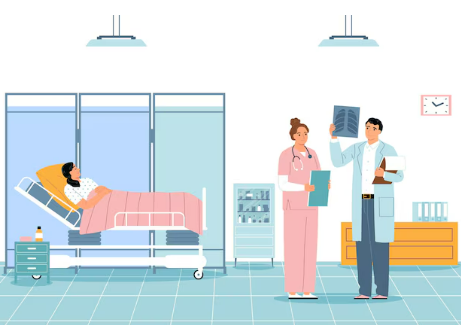🚨 Can You Afford Medical Bills Without Insurance in the U.S.?
In the U.S., even a simple hospital visit can cost hundreds of dollars. Without insurance, unexpected medical bills can be overwhelming. So, which health insurance should you choose, and how can you use it effectively?

📌 Table of Contents
- Understanding the U.S. Healthcare System
- Why Health Insurance is Essential
- Types of Health Insurance in the U.S.
- How to Enroll & Best Insurance Websites
- How to Use Your Insurance at a Hospital
- How to Get Medical Care Without Insurance
- Emergency Medical Care Options
- Frequently Asked Questions (FAQ)
1. Understanding the U.S. Healthcare System
The U.S. has a privatized healthcare system, meaning most hospitals and clinics are privately owned. There is no universal health insurance, making medical costs extremely high. Hospital fees vary by provider and can be unpredictable.
✅ Key Features of the U.S. Healthcare System
✔️ Without insurance, hospital bills can be extremely expensive (e.g., ER visit: $1,000–$3,000+).
✔️ Even with insurance, deductibles and co-pays apply.
✔️ Patients typically visit a Primary Care Physician (PCP) first before seeing a specialist.
✔️ Emergency Rooms (ERs) are the most expensive option—consider Urgent Care for non-life-threatening issues.
2. Why Health Insurance is Essential
🚑 Estimated Medical Costs Without Insurance
- General doctor visit: $100–$300+
- X-ray: $100–$1,000
- MRI scan: $1,000–$3,000
- ER visit: $1,000–$10,000+
✅ How Insurance Helps
✔️ Lowers medical expenses by covering a portion of the cost.
✔️ Provides discounts for in-network hospitals.
✔️ Prevents financial hardship in medical emergencies.
3. Types of Health Insurance in the U.S.
There are several types of health insurance, each with its own benefits.
🔹 Employer-Sponsored Insurance
✔️ Provided by your employer, with shared costs.
✔️ Most working Americans use this type of insurance.
🔹 Marketplace Insurance (Obamacare)
✔️ Purchased through the government’s marketplace (HealthCare.gov).
✔️ Subsidies available based on income.
📌 Where to apply: HealthCare.gov
🔹 Medicare (For Seniors & Disabled Individuals)
✔️ Available for 65+ years old or those with qualifying disabilities.
✔️ Government-run program with various coverage levels.
🔹 Medicaid (For Low-Income Individuals)
✔️ Government-supported insurance for low-income individuals.
✔️ Eligibility varies by state.
📌 More info: Medicaid.gov
🔹 Private Health Insurance
✔️ Offered by private insurers (e.g., Blue Cross Blue Shield, Aetna, Cigna, UnitedHealthcare).
✔️ More expensive but provides wider coverage.
📌 TIP: Your employment status, income, and state of residence determine which insurance options are available to you.
4. How to Enroll & Best Insurance Websites
✅ How to Get Health Insurance
1️⃣ Choose employer-sponsored insurance (if available).
2️⃣ Apply for government programs (Medicare, Medicaid, Marketplace).
3️⃣ Purchase private health insurance.
✅ Best Websites for Comparing & Enrolling in Health Insurance
✔️ HealthCare.gov (Obamacare)
✔️ eHealthInsurance (Private insurance comparison)
✔️ Medicaid.gov (Low-income insurance)
✔️ Medicare.gov (For seniors)
📌 TIP: Open Enrollment for Obamacare happens once a year, so check deadlines!
5. How to Use Your Insurance at a Hospital
🏥 Steps for Using Health Insurance in the U.S.
1️⃣ Find an in-network hospital (Check if the provider accepts your insurance).
2️⃣ Schedule an appointment with a Primary Care Physician (PCP).
3️⃣ Show your insurance card & pay a co-pay.
4️⃣ Review any additional bills that may come later.
📌 TIP: If possible, visit an Urgent Care clinic instead of the ER to save money!
6. How to Get Medical Care Without Insurance
If you don’t have insurance, medical costs can be overwhelming. However, some options can help:
✅ Find Low-Cost or Free Clinics
✔️ Federally Qualified Health Centers (FQHCs)
✔️ Community Health Centers
✔️ University hospital clinics
✅ Save Money on Prescription Medications
✔️ Use GoodRx for discounted prescriptions.
✔️ Buy medications from Walmart, Costco, or CVS for lower prices.
7. Emergency Medical Care Options
🚨 ER vs. Urgent Care – What’s the Difference?
✔️ Emergency Room (ER): For life-threatening conditions (heart attacks, major injuries, severe breathing issues).
✔️ Urgent Care: Cheaper & faster for minor issues (fever, flu, minor injuries).
📌 TIP: If it’s NOT a life-threatening emergency, go to Urgent Care instead of the ER!
8. Frequently Asked Questions (FAQ)
❓ Q1: Can I live in the U.S. without health insurance?
➡️ Yes, but medical care is extremely expensive, so it is NOT recommended.
❓ Q2: Can short-term residents get health insurance?
➡️ Yes, travel insurance or short-term health plans are available.
❓ Q3: How can I lower prescription drug costs?
➡️ Use GoodRx or shop at Walmart, Costco, or CVS.
❓ Q4: What if I don’t have employer-sponsored insurance?
➡️ Apply for Obamacare or private insurance.
✅ Conclusion: Health Insurance is Essential in the U.S.! Medical care in the U.S. is extremely expensive, so having health insurance is crucial. Understand the different types of insurance and choose the best plan for your needs to ensure affordable healthcare!
'Healthy & lifestyle (English ver.)' 카테고리의 다른 글
| Must-Have Apps & Services for a Healthy Lifestyle (14) | 2025.03.21 |
|---|---|
| Best Laptops of 2025 in the U.S.: Performance, Value, and Portability Comparison (3) | 2025.03.18 |
| Must-Have Apps & Services for a Healthy Lifestyle (0) | 2025.03.18 |
| The Connection Between Stress and Sleep: Why Am I So Tired? (0) | 2025.03.16 |
| Can't Visit a Doctor? Essential Over-the-Counter Medicines You Can Buy in the U.S. (0) | 2025.03.16 |